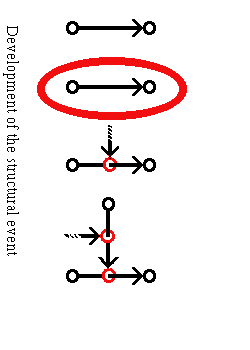High Path: The Big Push
E. Extending the system
1. VIRTUAL CONTEXTS
Add a new kind of location, called a "virtual context"
- A virtual context is a whole where the particulars include (or incorporate) a number of locations, e.g. the 6 pages in the red area on the HyprLink graph.
- The locations incorporated in a virtual context make up a set of locations.
- The set of locations may be arbitrary -- chosen as one pleases (but meaningful virtual contexts are the important ones)
- A location that is virtual context in one event may be a detail in another event
- "Virtual" contrasts with "real" (pages are real locations).
- The words real and virtual are borrowed from classical optics. Distortion affects all
optical images, whether real or virtual.
2. THE GOAL OF DEVELOPMENT
We want the words "Ridge Route" to
have co-ordinated meanings, including the following:
- the static structual interconnection of pages and links (seen
in the red area of the graph)
- the visitor's experience in following the development of ideas
in a succession of pages seen on the browser
3. EXTENDING THE CONCEPT OF LOCATION
Expand the definition of location to include:
- pages (as before)
- virtual contexts
- context-detail pairs: each pair (i.e. each link) is a location
4. EXTENDING THE CONCEPT OF CONTEXT-DETAIL PAIR
Expand the definition of context-detail pairs to include:
- pairs where a page is the context and a link identified with another page is the detail (as before)
- pairs where a virtual context is the context and a page incorporated in the set is the detail
- pairs where a virtual context is the context and a context-detail pair is the detail
(e.g., the pair where Water Trail is the context and the forward link from stage_1 to stage_2 is the detail)
F. Notating the extension
The extended system interfaces with device_2.
The essential HyprLink graph has 19 page locations and 79 links. A fully extended graph would also include
19 page locations, 79 link locations and at least 5 virtual contexts (over 100 locations total), too many
for this medium. Some partial views should enable the visitor to envision the extended
graph.
 Focus on six pages, ridjguid and device_n, and the links between those six pages.
This area of focus is the
red area in the graph. This area constitutes the core of Ridge Route.
Focus on six pages, ridjguid and device_n, and the links between those six pages.
This area of focus is the
red area in the graph. This area constitutes the core of Ridge Route.
1. Event Notation
Before the extension:
- Locations and their abbreviations
- g=ridjguid, n=device_n
- Context-detail pairs
- (g-0) (g-1) (g-2) (g-3) (g-4) (0-1) (1-0)
(1-2) (2-1) (2-3) (3-2) (3-4) (4-3) (0-g) (1-g) (2-g) (3-g) (4-g)
After the extension:
- Locations:
- add the following virtual context: RR = Ridge Route
- add the context-detail pairs from before the extension, e.g. (g-0)
- Context-detail pairs:
- add the following pairs: (RR-g) (RR-0) (RR-1) (RR-2) (RR-3) (RR-4)
-
- add the following pairs: [RR-(g-0)] [RR-(g-1)] [RR-(g-2)] [RR-(g-3)] [RR-(g-4)] [RR-(0-1)] [RR-(1-0)]
[RR-(1-2)] [RR-(2-1)] [RR-(2-3)] [RR-(3-2)] [RR-(3-4)] [RR-(4-3)] [RR-(0-g)] [RR-(1-g)] [RR-(2-g)] [RR-(3-g)] [RR-(4-g)]
brackets -- [ - ] -- are the
same as parentheses -- ( - ): using both to avoid eyestrain
2. Dot-and-arrow notation
An image shows the development of the event (or link):
3. Matrix Notation
 Begin with the red area in the hyprlink graph and
identify each link as a particular location, named with a letter
Begin with the red area in the hyprlink graph and
identify each link as a particular location, named with a letter

The extension in matrix notation. Each letter naming
a link is identified with a corresponding row and column in the matrix.



The Ridge Route virtual context
has been introduced. Ridge Route can be defined in different ways, including or excluding locations
according to the designer. This structure is the same as the one defined for Event Notation.
Forward on High Path




All materials copyright by Robert Kovsky, 1997.
 Focus on six pages, ridjguid and device_n, and the links between those six pages.
This area of focus is the
red area in the graph. This area constitutes the core of Ridge Route.
Focus on six pages, ridjguid and device_n, and the links between those six pages.
This area of focus is the
red area in the graph. This area constitutes the core of Ridge Route. Focus on six pages, ridjguid and device_n, and the links between those six pages.
This area of focus is the
red area in the graph. This area constitutes the core of Ridge Route.
Focus on six pages, ridjguid and device_n, and the links between those six pages.
This area of focus is the
red area in the graph. This area constitutes the core of Ridge Route.
 Begin with the red area in the hyprlink graph and
identify each link as a particular location, named with a letter
Begin with the red area in the hyprlink graph and
identify each link as a particular location, named with a letter




